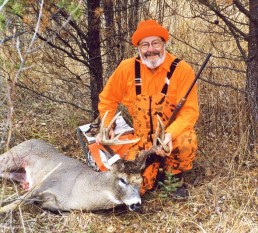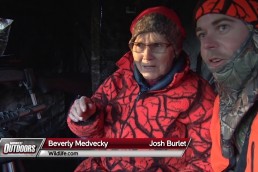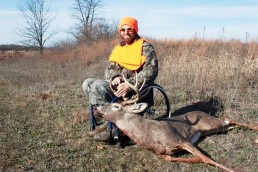Why You Should Learn to Stand Hunt at Ground Level
SHARE THIS POST
Portable tree stands were unknown 50 years ago and stand hunting meant setting up at ground-level. Today, stand hunting usually means sitting or standing on a platform well above the ground in a tree or atop a manmade tower. Although hunting from a tree stand is still productive, hunters who hunted from an elevated platform from the 1960s until about the mid-1980s agree: Tree stand hunting isn’t nearly as productive as it once was.
Why? Because after many millions of hunters using tree stands for nearly 50 years have hunted them, whitetails are looking up. Whitetails older than yearlings are now adept at discovering, identifying and avoiding hunters in tree stands. Although mature whitetails have adapted well to tree stand hunting, stand hunters have not adapted well to whatever whitetails do to avoid them.
One of the first things I discovered during my early years of hunting-related research with wild deer in northern Minnesota was that my primitive, 6-foot-high tree stands made me astonishingly invisible to eyes, ears and noses of whitetails. That is, as long as I stayed perfect still. Many passed so near to my early, 6-foot-high platforms that I could have reached down and touched them. Not wanting to miss a chance to observe or fire at a deer anywhere around me, I cut all branches from above my platforms up to a point well above my head. I also cut interfering branches from trees around my stands and cleared one or two wide shooting lanes. Although primitive, these tree stands provided opportunities to observe activities of up to 20 unsuspecting deer per day in decent weather. Plus, they provided hunting success so phenomenal, that my hunting partners and I decided we were skilled enough to limit ourselves to taking mature bucks only. After about 10 years, however, increasing numbers of mature whitetails spotted us on our platforms, reacted with obvious alarm and thereafter avoided many of our tree stands.
As opportunities to take mature bucks dwindled, we resorted to using more and more new innovations to restore our accustomed hunting success. By the mid-1980s, we used three or more stand sites per hunter, per hunting season. Our portable tree stands were 9 feet above the ground and we tacked evergreen boughs to tree trunks around our tree stands to hide our silhouettes. Natural openings became shooting lanes or shooting windows and we no longer cleared shooting lanes. We routinely used fox urine as a cover scent and regularly used buck lures such as doe urine containing doe-in-heat pheromone and buck grunt calls and sometimes we rattled antlers. These innovations improved our buck hunting for a few years, but it was soon obvious our heyday of buck hunting was coming to an end. This prompted me to begin new research that would hopefully discover new ways to hunt mature bucks successfully.
On the final morning of our firearms hunting season in 1990, I took a dominant breeding buck 30 minutes after sitting down on a folding stool amid some young spruce trees for the very first time. While field dressing that buck, my mind began to fill with a deluge of exciting reasons why a simple camp stool could enormously improve hunting success for mature bucks and other deer. A stool would enable me to stand hunt at ideal stand sites every time. For example, I could quickly set up at a site that provided adequate, silhouette-hiding, natural cover downwind or crosswind of where I expected a buck to appear, no matter what direction the wind was blowing. This was usually impossible to do while using an elevated stand. Such cover is available almost everywhere I hunt, but not regularly in trees. A stool like the one I used was silent when backpacked and silent when placed on the ground. It was silent when set-up and silent while I sat it in it. My portable tree stands always made some noise. The buck I had taken and the doe with it had no idea I was near. This would have been an impossible chain of events had I carried a portable tree stand to use at that site. A stool would provide a dry and comfortable seat at a 100-percent safe, 18 inches above the ground. It was easy to use for 4 to 6 hours without appreciable physical agony—not the case with any of the different brands of portable tree stands I had owned. Best of all, it would give me complete freedom to hunt wherever a mature buck was located or would be later that day or the next morning. This enabled me to keep close to such bucks every day of a hunting season.

Are you enjoying this post?
You can be among the first to get the latest info on where to go, what to use and how to use it!
I soon custom made a folding, camo-painted stool with a 3/4-inch oak framework, a canvas seat, shoulder straps and an attached packsack.
How would I know exactly where mature bucks and other deer were in the morning or likely would be later that day or the next morning? Fresh deer tracks and droppings (and sometimes other deer sign) of unalarmed, walking, whitetails provided the answer. All deer trails funnel down to feeding areas where the odds of seeing deer on trails are infinitely greater. Moreover, whitetails are most likely to be seen and most easily seen in feeding areas, at least until deer feeding there discover a hunter waiting in ambush near an edge. This typically happens within 1 to 3 half days of stand hunting. Until then, the deer that made the fresh tracks are almost certain to return to feed early in the morning or late in the afternoon. Knowledge provided by fresh deer signs and the ability to take quick advantage of this knowledge was key. Stools at ground level sites, using natural, unaltered cover as a blind, adjacent to a feeding areas enabled my three sons and me to tag most of the 94 mature bucks we took on public land since 1990.
Great hunting success while stand hunting at ground level is real. All the advantages it provides a hunter are real. If you are growing weary of all the work involved in setting up tree stands and dwindling success from them, sooner or later, ground level stand hunting will become your next favorite way to hunt deer. MWO
Dr. Ken Nordberg has written nearly 900 magazine articles and 13 books on the habits and hunting of whitetails and black bears, including the “Whitetail Hunter’s Almanac” series. He also produced “Doc’s Buck and Bear Hunting School” videos. His encyclopedic website with whitetail hunting tips is at drnordbergondeerhunting.com and his blog is at drnordbergondeerhunting.wordpress.com. Check out his Twitter page @DrNordberg and his presentations at youtube.com/Dr. Ken Nordberg.
MWO
SHARE THIS POST
Did you enjoy this post?
You can be among the first to get the latest info on where to go, what to use and how to use it!
Dr. Ken Nordberg
Based on his 55 years of field research, Dr. Ken Nordberg has written more than 800 magazine articles, 12 books on whitetails—including the famous Whitetail Hunter’s Almanac series—five books on black bear hunting and produced Buck and Bear Hunting School videos. You may peruse his encyclopedic website with whitetail hunting tips: drnordbergondeerhunting.com, his blog: drnordbergondeerhunting.wordpress.com, or social media pages.



